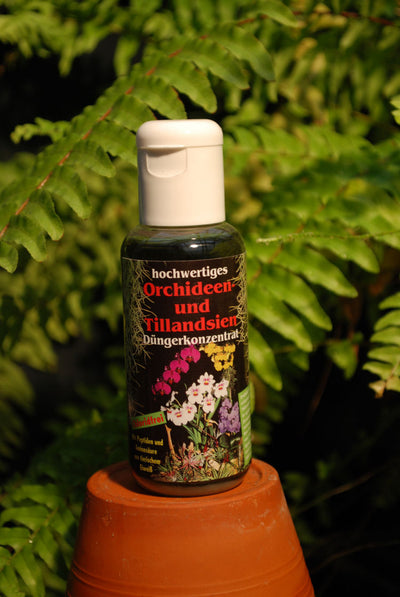Diving Orchids | Water orchids properly
What does "orchid diving" mean?
If you think that "orchid diving" is a sport and means you look for orchids underwater, you are wrong. Because this is a type of watering that is often used for orchids that are privately owned. This process is also called an immersion bath.
In general, hanging flowers and plants with high water requirements like immersion baths. In principle, you place the orchid with the pot in a bucket filled with water. However, you have to pay attention to important details so that quantities of water do not flow onto the plant that the roots cannot absorb. The following paragraph deals with the important details and the correct procedure for diving orchids.

Diving orchids - This is how it works
The best time to dive orchids is in the morning hours. This gives the orchid enough time to dry off for the rest of the day before the temperatures drop again in the evening and at night.
Dipping orchids - preparation
Before we get down to business, a few preparations must first be made, which are as follows:
- Place the plastic tub or bucket in an area that offers protection from the sun
- fill in fresh, room-warm and lime-free water (i.e. prefer rainwater to tap water)
- have a measuring cup, a jug or a large glass at hand
- have a kitchen towel or hand towel ready
- If available, have a drip grid or something similar ready, which you can place over the plastic tub or bucket after diving so that the excess water can drip off better
Diving orchids - instructions
As soon as these preparatory steps have been completed, the orchids can be dipped. Potted and substrate-less orchids are equally suitable for this. This is how it is done:
- Take the culture pot out of the cachepot
- tilt the pot slightly
- slowly sink into the water
- at the same time pour water from above using a cup, a jug or something similar
- stand the plant upright just before the ground
- leave the orchid in the immersion bath for a while
- Lift out the pan and place on the rack to drain
- Dry off the water in the leaf axils using kitchen paper
- only when there is no more water dripping can you put the orchid back in its pot and then back in its place
It is difficult to say exactly how long you have to immerse the pot under water, but the roots of the orchid should appear green after the orchid has been immersed . However, the immersion time depends on the location of the plant. It is true that the wetter and cooler the environment, the shorter the dive duration should be and the longer the bath breaks. As a rule, it is said that the immersion bath rhythm is about one to two weeks. If you also water the orchid, you should wait longer than two weeks.
With hanging orchids the whole thing is a little different, namely here the roots are hung in the immersion bath and not placed in it. But here, too, it is important that the plant then has enough time to drain well.
It is important that you dive newcomers separately, otherwise they could transmit diseases and pests to other plants.

Other types of watering
Of course, there are other types of watering for orchids in addition to the orchid immersion bath . Sensitive orchids can become ill or even die in the worst case if they are treated incorrectly, which is why other types of irrigation are discussed below.
Rain
Many orchid species are native to the world's tropical rainforests. Due to its proximity to the equator, the weather there is quite predictable. It rains once a day there, which is very convenient for the orchids in the local climate. Epiphytes in particular, i.e. orchids that grow on other plants or trees, are dependent on natural watering methods. In addition to the rain, this also includes the high humidity that prevails around the equator. However, heavy rain showers pose a challenge for orchids.
Other orchid species, which are native to the Himalayas or the Andes, for example, do not necessarily have the luxury of daily rain or high humidity. However, orchids can also survive long periods of drought due to their ability to store water for longer periods of time. Because of this, you don't have to water them every day.
Shower
A rather powerful and short shower for orchids comes relatively close to natural watering, such as rain. Ideally, you shower your orchids in the hot summer months, as they can dry off within a few hours.
However, you should not use tap water for this , which is very calcareous. You can easily find out the water values on the website of the waterworks. In addition, you have to make sure that the water can drain off without any problems so that, as in nature, no waterlogging forms and root rot occurs.
Pour
Watering is probably the most typical way of watering indoor plants. As a rule, orchids should only be watered if they have an urgent need for water and there is no time for a dip. With a simple weight test you can check whether there is a need for watering or not.
To do this, take the culture pot out of the cachepot, if the plant feels light, you should water it. If it is not clear, it is better not to water, because orchids are quite capable of surviving dry periods, whereas too much water causes root rot and severely damages the orchid.
Accordingly, when watering, as with all other types of watering for orchids, there should not be a drop of water in the lower pot after the process in order to avoid waterlogging. In addition, when watering, lime-free rainwater at room temperature should be preferred to tap water.
Planter Orchids
With this type of watering, the integrated water reservoir is to be filled up so that rising moisture is created, which can rise up to the leaves of the orchid. Depending on the temperature and light conditions, you water the orchid as normal. The excess water is not removed, but runs into the integrated water reservoir. However, with this type of irrigation there is a risk that too much water will collect at the bottom of the pot and root rot will occur.
orchitope
The orchitop represents a special case here. On the one hand, an orchitop is not a type of irrigation at all, but a vessel in which orchids can be cultivated. On the other hand, the decision about the type of irrigation is virtually made for you.
An orchitop consists of a wall with sticks designed to provide the roots with sufficient light and air. A coaster is also included, this is filled with expanded clay or Seramis. The only thing you have to do now for the water supply is to keep refilling the coaster with water. The filling of the saucer, either expanded clay or Seramis, prevents waterlogging in the root ball. In addition, the evaporating water creates a local and humid microclimate, which is also typical in the rainforest and has a positive effect on the orchids.
shower bath
Most orchid growers use this type of watering. This is a combination of immersion bath and shower. In this case, the plants are mainly watered from above. The roots then absorb the water from the pools of water that form on the ground.
A big advantage of this type of irrigation is that the orchid leaves can also absorb water directly and the supply routes are therefore significantly shorter. Furthermore, this process also removes dust from the orchid, which opens the pores of the plant and thus enables better oxygen absorption.
When taking a shower, it is important to ensure that there is little water pressure on the shower head and that the water should be lime-free, otherwise unsightly stains will appear on the orchid leaves. It is also important that the orchid has enough time to drain and dry after the shower. To ensure this, you should use this type of watering in the morning hours.
spray
Spraying is something like a little insider tip . It is the ideal addition to dipping or watering orchids . You simply fill a hand sprayer and treat the top and bottom of each leaf with it. You can also spray the substrate with it if you really don't have time. You should also use lime-free water at room temperature for spraying.

Dipping or watering orchids - which is better?
Opinions differ on this question. But gradually it seems that experts are leaning towards dipping orchids rather than watering them. On the one hand, this is due to the fact that the water absorption through orchid diving is very similar to that in nature. There is also a risk of overwatering when watering, for example due to watering too often. Water then collects at the bottom of the orchid pot, which the roots can no longer absorb. This leads to waterlogging and thus to root rot, which in turn leads to the death of the plant.
However, there are also risks when diving that can only be ruled out by taking the right approach. One such risk is that scuba diving makes it much easier to spread diseases and pests unless you change the water every time. Furthermore, of course, dipping takes more time than watering, but it also has the advantage that evaporation creates a high degree of moisture around the plant, which benefits it. Also, as long as you drain the orchids long enough and stick to a healthy dipping cycle, root rot is less likely to develop from dipping.

Difference gardening and home
In a nursery, you usually have completely different options for watering the plants than at home. Plant nurseries do not dip or water. Instead, the orchids are watered through a so-called shower bath using a garden hose with a shower attachment.
Home gardeners usually choose between dipping and watering. This is usually due to a lack of capacity and a shower bath for orchids is only really worthwhile if you have a lot of them and want to water them at the same time. In addition, a nursery offers the orchids optimal and mostly constant environmental conditions. Such a standard is difficult to achieve at home.

Conclusion
Finally, it should be said again that orchid diving is probably the best and most natural method of watering privately owned orchids, as long as you of course pay attention to the correct procedure. If it has to be quick because you don't have much time, there are good alternatives to the immersion bath, but you should use them with care.
It is also important when caring for orchids not only to listen to the care instructions on the plug-in signs when buying them in garden centers or Bauhaus stores, for example. The care of orchids must always be adapted and coordinated with their individual environment.















Eine meiner Orchideen hat ausserhalb des Topfes mehr Wurzeln als im Topf und hat dadurch das Gleichgewicht verloren. sWas machen? Nach jeder Blühte fällt ein Blatt ab, blüht sehr oft. Manchmal bildet sie sofort nach dem Verblühen am gleichen Stängel wieder Blüten. Es ist eine Variante mit sehr grossen, weissen Blühten.
Bin gespannt was sie mir raten. Besten Dank!
Leave a comment